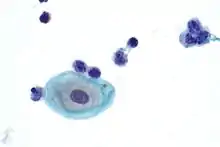
Micrograph showing navicular cell in extremely high magnification
Navicular cell is a boat-shaped benign epithelial cell seen in Pap smear.[1] They are seen in pregnancy (most prominently during smears taken in the second trimester),[2] second half of menstrual cycle, during menopause and in women using medroxyprogesterone acetate (depo-provera) for contraception. Navicular cells have folded edges, with a thickened outer rim of cytoplasm and an eccentric nucleus. They contain abundant glycogen in the cytoplasm, giving it a central yellow halo. The cytoplasm appears golden, refractile and granular under the microscope. In depo-provera users, the high progesterone levels result in more exfoliation of superficial squamous cells, thereby causing navicular cells to appear in Pap smear.[3]
References
- ↑ Harshmohan (2010). Harshmohan's textbook of Pathology (5 ed.). New Delhi: Jaypee Publications. p. 280. ASIN 9351523691.
- ↑ Sattenspiel, Edward (1950). "Vaginal cytology in normal pregnancy". Obstetrical & Gynecological Survey. 5 (6): 800. doi:10.1097/00006254-195012000-00003. Retrieved 9 December 2016.
- ↑ EE, Volk (23 September 2000). "Cytologic findings in cervical smears in patients using intramuscular medroxyprogesterone acetate (Depo-provera) for contraception". Diagnostic Cytopathology. 23 (3): 161–4. doi:10.1002/1097-0339(200009)23:3<161::AID-DC4>3.0.CO;2-O. PMID 10945902. S2CID 39180738.
Gallery
 High magnification view
High magnification view Very high magnification view
Very high magnification view
This article is issued from Wikipedia. The text is licensed under Creative Commons - Attribution - Sharealike. Additional terms may apply for the media files.